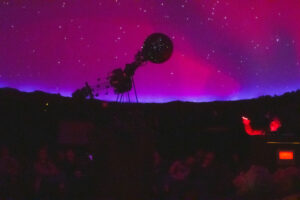Astronomy Facilities
Luther College maintains an observing platform atop Valders, the Luther College science building. We are grateful to the Roy J. Carver Charitable Trust for their support of major upgrades to our observing facilities (Grant # 00-50).
Observing Facilities and Equipment

The planetarium at Luther College was part of the original plans for the new Valders Hall of Science. The planetarium was installed in 1964, about one year after the completion of the science building. The planetarium projector, control panel, domed ceiling, lighting, and circular seating were purchased at a cost of about $35,000 and installed by Spitz Space Systems of Chadds Ford, PA. The projector is the Spitz Model A3P projector that originally came with an incandescent light source. About five hundred of the Spitz A3P projectors were manufactured and the vast majority of them are still in service according to the Spitz technician who has been at Luther to service the projector.
In 1980, the light source was upgraded to a 20-watt xenon arc lamp that was much brighter. This, however, required the replacement of over 120 star cell lenses to achieve the correct focus on the star images. The planetarium will seat 65 adults in a circular arrangement. The majority of the shows given in the planetarium are for public groups who make reservations. All shows are “live” which facilitates interaction and promotes questions. On average, about 75 shows are given each year in the planetarium.
In October of 1998, Luther President Jeffrey Baker announced that the planetarium had officially been named the Emil C. Miller Planetarium. Dr. Miller was a long time professor and physics department head and was the driving force behind getting the planetarium along with the observatory facility eight miles outside of Decorah.
The motorized sliding roof on top of Valders Hall of Science makes it a versatile observing facility. It includes four telescopes (two-12 inch telescopes, and two-10 inch telescopes).
All of the telescopes are Meade Schmidt-Cassegrain telescopes that have the ability to be controlled by a computer.
The observation deck atop Valders is used for classes, public observing, special observing sessions with groups and undergraduate research. The 19¼’ x 18½’ facility has five permanently mounted telescopes—two 12” f/10 Meade LX200s, two 8” f/10 Meade LX200s and a 16” diameter f/10 Meade LX200. The observing area is fully covered by a motor-driven retractable roof provided by Schwab Company of Winona, Minnesota. Be sure to follow the rooftop observatory link to find a video clip of the motorized roof in action.
The observing facilities are supported by a wide array of instrumentation. We mention only some of it here. We use five CCD cameras—a Meade 216XT, a Meade 416XTE, a Meade 1616XT, an SBIG STL-1001E and an Apogee grade 1 AP6E. We use BVRI filters from Custom Scientific. A student-constructed fiber optic spectrograph is available for research studies. A variety of barlow lenses, focal reducers and eyepieces are available for use. Each telescope is equipped with a Kendrick electric dew removal system. These dew zappers have proven to be an invaluable observatory component.